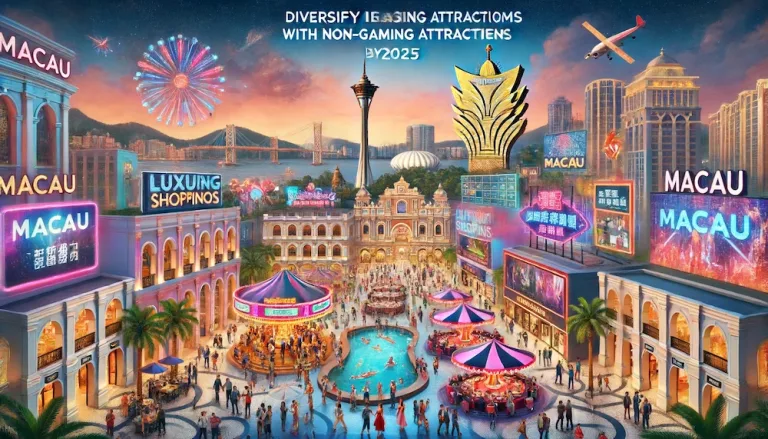In an effort to reduce reliance on casino revenues and attract a broader range of tourists, Macau is planning to diversify its gambling industry by introducing a variety of non-gaming attractions by 2025. This strategic move is aimed at transforming Macau into a more versatile tourist destination, offering a blend of entertainment, culture, and leisure activities. This article explores the details of Macau’s diversification plan, its expected impact on the gambling industry, and what tourists and operators can anticipate.
Overview of the Diversification Plan
Government Initiative
The Macau government has announced a comprehensive plan to diversify the region’s tourism offerings beyond its renowned casinos. This initiative includes the development of cultural sites, family-friendly attractions, luxury shopping centers, and entertainment venues. The goal is to create a well-rounded tourist destination that appeals to a wider audience.
Investment in Infrastructure
Significant investments will be made in infrastructure to support the diversification plan. This includes the development of new transportation links, such as improved ferry services and expanded airport facilities, to make Macau more accessible to international visitors. Additionally, enhancements to existing infrastructure, such as roads and public transportation, will ensure a seamless visitor experience.
Expected Impact on the Gambling Industry
Broader Tourist Demographic
By introducing non-gaming attractions, Macau aims to attract a more diverse range of tourists, including families, culture enthusiasts, and leisure travelers. This broader demographic will help stabilize the region’s tourism industry, making it less dependent on high-stakes gamblers and more resilient to fluctuations in the gambling market.
Increased Revenue Streams
Diversifying into non-gaming attractions will create new revenue streams for Macau. While casino revenues have historically dominated the region’s economy, the addition of attractions such as theme parks, museums, and entertainment shows will generate income from ticket sales, merchandise, and dining. This diversification will contribute to the overall economic stability of Macau.
Enhanced Visitor Experience
The introduction of non-gaming attractions will enhance the overall visitor experience in Macau. Tourists will have more options for entertainment and leisure, making their stay more enjoyable and memorable. This positive experience is likely to encourage repeat visits and boost word-of-mouth promotion, further increasing tourist arrivals.
Challenges and Criticisms
Balancing Development and Heritage
One of the challenges of Macau’s diversification plan is balancing development with the preservation of its cultural heritage. As new attractions are developed, it is essential to ensure that the region’s unique cultural identity and historical sites are protected. This requires careful planning and collaboration with heritage preservation organizations.
Competition from Neighboring Destinations
Macau faces competition from other tourist destinations in the region, such as Hong Kong and Singapore, which also offer a mix of gaming and non-gaming attractions. To stand out, Macau must ensure that its new attractions are unique and offer a high-quality experience. This involves investing in innovative and world-class attractions that can compete on a global scale.
Ensuring Sustainable Development
Sustainable development is a key consideration in Macau’s diversification plan. The region must ensure that new attractions are environmentally friendly and contribute to the long-term sustainability of the tourism industry. This includes implementing green building practices, promoting eco-tourism, and reducing the environmental impact of tourism activities.
Future Prospects and Developments
Innovative Attractions
The future of Macau’s tourism industry will likely see the development of innovative attractions that leverage cutting-edge technology. This could include immersive virtual reality experiences, interactive museums, and high-tech entertainment shows. By staying at the forefront of technological advancements, Macau can continue to attract and engage tourists.
Strengthening Regional Collaboration
Collaboration with neighboring regions and countries will play a crucial role in the success of Macau’s diversification plan. Joint marketing campaigns, regional tourism packages, and cross-border events can enhance Macau’s appeal as a tourist destination. Strengthening regional ties will also facilitate the exchange of best practices and resources.
Expanding Cultural Offerings
Macau’s rich cultural heritage provides a strong foundation for expanding its cultural offerings. Future developments could include more cultural festivals, art exhibitions, and heritage tours that showcase the region’s unique history and traditions. Promoting cultural tourism will attract visitors interested in experiencing Macau’s authentic charm.
Conclusion
Macau’s plan to diversify its gambling industry by introducing non-gaming attractions by 2025 marks a significant step towards creating a more versatile and resilient tourism destination. While there are challenges to address, the benefits of attracting a broader tourist demographic, generating new revenue streams, and enhancing the visitor experience are substantial. As the region invests in innovative attractions and sustainable development, the future of Macau’s tourism industry looks promising. Whether you are a tourist seeking diverse entertainment options or an operator looking to capitalize on new opportunities, Macau’s diversification plan offers a pathway to a vibrant and sustainable tourism landscape.

Garry Sputnim is a seasoned journalist and storyteller with over a decade of experience in the trenches of global news. With a keen eye for uncovering stories that resonate, Alex has reported from over 30 countries, bringing light to untold narratives and the human faces behind the headlines. Specializing in investigative journalism, Garry has a knack for technology and social justice issues, weaving compelling narratives that bridge tech and humanity. Outside the newsroom, Garry is an avid rock climber and podcast host, exploring stories of resilience and innovation.


